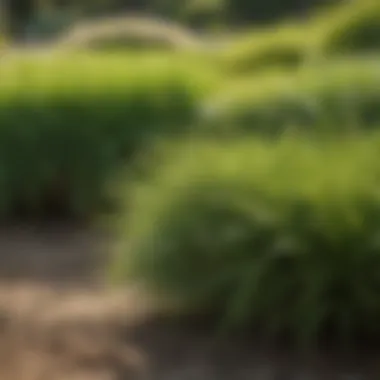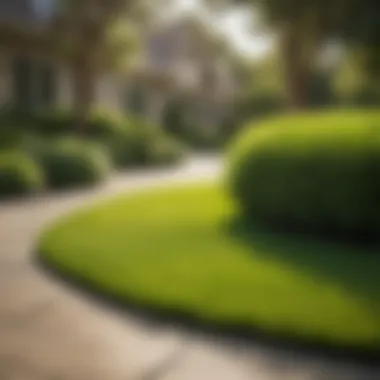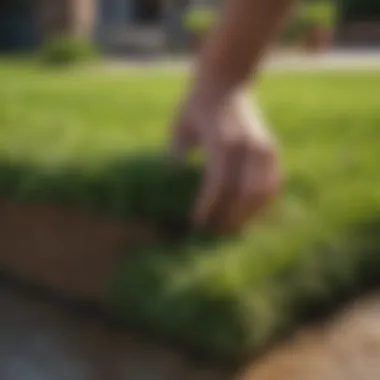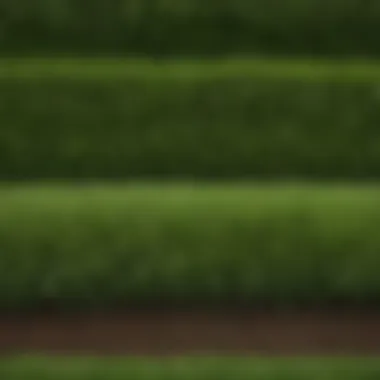Understanding the Cost of Zoysia Sod: A Comprehensive Analysis


Intro
Zoysia sod has gained popularity in various regions for its resilience and aesthetic appeal. It is more than just a landscaping choice; it represents a significant investment for homeowners and agricultural enthusiasts alike. This article delves into the multifaceted aspects of zoysia sod, focusing on the cost implications tied to its purchase and installation.
Understanding the pricing of zoysia sod requires a clear grasp of the different factors at play. These include the various types of zoysia grass, their specific growth conditions, and the associated costs involved in acquiring and installing them. Besides the initial cost, ongoing maintenance is a crucial factor for potential buyers.
In this analysis, we will break down everything from soil preparation to installation techniques, guiding readers through critical financial considerations. This comprehensive guide aims to equip farmers and gardening enthusiasts with the knowledge necessary for informed decision-making regarding zoysia sod.
Preface to Zoysia Sod
The selection of sod type is crucial for any landscaping project. Understanding zoysia sod is a vital part of this process. It can influence not only the look of the yard but also its long-term maintenance and environmental impact. Zoysia sod offers specific benefits that differentiate it from traditional turf options, making it a cultivated choice for many homeowners and agricultural farmers.
Zoysia grass is known for its heat and drought resistance, which is a significant factor, especially in regions experiencing climatic stresses. This resilience makes it an appealing option, ensuring that the investment made in sod does not go to waste. Considering factors such as the intended use, local climate, and type of soil can help in making informed choices for your landscaping needs.
What is Zoysia Grass?
Zoysia grass is a warm-season perennial grass species that thrives in warm and humid climates. It has a deep root system, allowing it to endure periods of drought and recover quickly from stress. This makes zoysia grass an excellent option for lawns, golf courses, and sports fields.
There are several varieties of zoysia grass, including Emerald, Meyer, and El Toro, each offering distinct characteristics that can suit different environments. Emerald zoysia is often favored for its lush appearance and fine texture, while Meyer zoysia provides excellent shade tolerance. El Toro zoysia stands out for its rapid growth.
In summary, zoysia grass is recognized for its durability, minimal water needs, and ability to adapt to varying soil conditions, contributing to its popularity in both professional and residential landscaping.
Popular Uses of Zoysia Sod
Zoysia sod can be employed in various applications, making it versatile for different landscaping needs.
- Residential Lawns: Homeowners often choose zoysia for its aesthetic appeal and low maintenance requirements. Many enjoy its plush, dense texture, which enhances curb appeal and offers comfort underfoot.
- Golf Courses: Its ability to withstand foot traffic and recover quickly from wear makes it ideal for golf course fairways and greens.
- Parks and Sports Fields: Its resilience and drought tolerance also lend themselves well to parks and sports fields, allowing for year-round playing conditions.
In addition to appearances and longevity, zoysia sod can play a role in ecological stability. By opting for zoysia sod, landowners can help reduce water usage while preserving soil quality.
"Choosing the right sod for your landscape needs is essential for long-term satisfaction and sustainability."
With its numerous benefits and appropriate applications, zoysia sod has become a favorable option for many seeking to enhance their outdoor spaces.
Factors Influencing the Cost of Zoysia Sod
Understanding the cost of zoysia sod requires a comprehensive look at its influencing factors. These elements contribute significantly to the pricing structure, and it is essential for potential buyers to grasp them before making an investment. The following factors determine the overall cost, helping buyers make informed decisions.
Type of Zoysia Grass
Different varieties of zoysia grass present unique features and benefits that can influence the cost significantly.
Emerald Zoysia
Emerald Zoysia is known for its lush, dark green color and dense growth pattern. It is a popular choice for its aesthetic appeal. This type is highly tolerant of heat and drought, making it suitable for warmer climates. However, it can be pricier due to its demand and quality.
A key characteristic is its slow growth, which means that once installed, it requires less frequent mowing. Owners may find this beneficial as it reduces maintenance time. Balancing the cost with its durability and beauty, Emerald Zoysia remains a top choice for many landscapers.
Meyer Zoysia
Meyer Zoysia is another widely recognized type. It grows well in a variety of soil and is resilient in different climates. This variety adapts well to both sunny and partly shaded areas, making it versatile for homeowners. Its capacity to spread quickly allows for faster coverage, hence potentially lowering installation costs over time.
This type also tends to recover quickly from wear and tear, which is advantageous for high-traffic areas. However, its price can sometimes be higher than other varieties due to these attractive qualities. Therefore, its long-term benefits should be weighed against initial costs.


El Toro Zoysia
El Toro Zoysia stands out for its quick establishment and robust nature. It grows moderately fast and, like Emerald, exhibits a rich green coloration. El Toro is particularly valued for its ability to thrive in diverse weather conditions. It often has a lower price point compared to Emerald, making it a viable option for those on a tighter budget.
However, it requires more mowing than the other types, which can lead to increased maintenance. Its growth pattern might not be as dense as Emerald or Meyer, but it plays a crucial role in offering a cost-effective solution while maintaining satisfactory aesthetics.
Sod Quality and Thickness
The quality and thickness of zoysia sod can heavily influence its cost. Thicker rolls tend to be more expensive since they establish quicker than thinner alternatives. High-quality sod not only provides better root systems but also offers improved resilience against pests and diseases. Buyers should consider investing in thicker, quality sod despite a higher upfront cost for long-term savings in maintenance and replacement.
Location and Climate
The geographical area where zoysia sod is purchased plays a critical role. Prices can vary significantly based on local demand and supply. For instance, areas with a warmer climate may have more access to zoysia sod, potentially lowering prices. Conversely, in regions with colder climates, zoysia sod may come at a premium due to its specialized care needs.
Climate conditions also affect how zoysia sod performs post-installation. Heat and sunlight requirements can determine whether zoysia will thrive or struggle, thus affecting its overall viability and cost efficiency over time. Understanding these factors is critical for anyone considering zoysia sod for landscaping.
Zoysia Sod Pricing Overview
Understanding the pricing of zoysia sod is a crucial element that influences purchasing decisions for both landscaping enthusiasts and agricultural professionals. This overview explores the cost implications of various factors such as type, quality, and location. By breaking down the average costs and the variables that affect pricing, buyers can make informed choices that align with their budget and project requirements.
Average Cost per Square Foot
The average cost per square foot of zoysia sod can vary significantly depending on several intrinsic factors. Generally, homeowners can expect to pay anywhere from $0.50 to $1.50 per square foot. Factors such as the type of zoysia grass selected, the quality of the sod, and market conditions play a key role in determining this price range.
For example, Meyer Zoysia is usually more affordable compared to Emerald Zoysia, which tends to be priced at the higher end due to its lush color and texture. Additionally, sod thickness can impact cost; thicker sod may come with increased pricing but offers benefits like quicker establishment.
It is prudent for consumers to compare prices from multiple suppliers to gauge a fair rate for their specific needs. Local market dynamics, seasonal demand, and supply chain variations will also influence the final price.
Factors that Impact Pricing
Several critical factors contribute to the pricing of zoysia sod, including:
- Type of Zoysia Grass: Different types come with distinct costs.
- Quality of the Sod: Higher quality sod generally commands a higher price.
- Sod Thickness: Thicker sod rolls can lead to increased expenses but may provide advantages in establishment and durability.
- Location: Geographic factors, including climate and local availability, can impact pricing. Regions with warmer climates often have better access to zoysia grass, perhaps leading to lower prices.
- Grower Reputation: Established growers may charge premium prices for their sod due to trust and quality assurance.
Understanding these factors allows buyers to navigate the marketplace effectively. Those evaluating zoysia sod must consider their priorities—be it cost savings, aesthetics, or durability—based on their specific needs and the regional climate.
Installation Costs
When considering zoysia sod for your landscaping project, understanding the installation costs is crucial. These expenses can significantly influence your overall budget and impact the quality of the installation itself. An effective installation not only ensures aesthetic appeal but also contributes to the longevity and health of the sod. Choosing between DIY installation and hiring professional services presents unique benefits and challenges, both of which deserve careful consideration.
DIY Installation vs. Professional Services
Deciding whether to complete the installation of your zoysia sod yourself or to contract professionals is a key choice. DIY installation can save you money, as you will not be paying for labor. However, this choice demands a reasonable level of skill and knowledge in landscaping. Novices might find zoysia sod tricky, especially when it comes to preparing the soil or ensuring proper rolling.
On the other hand, hiring professionals can provide peace of mind. They possess expertise in sod installation and may offer warranties on their work. However, this option comes with higher upfront costs, which could range widely depending on the company and the scope of your project.
Consider these factors:
- Your experience with landscaping
- The size of the area to be sodded
- Your budget constraints
- The time you have available for the project
It is essential to weigh these aspects carefully. If you decide to go the DIY route, make sure to research proper techniques and gather the necessary tools.
Labor Cost Estimates


Labor costs are a significant portion of the installation expenses associated with zoysia sod. When hiring a professional service, labor prices usually fluctuate based on several factors, including:
- Geographic location: Costs tend to be higher in urban areas or regions with higher living expenses.
- Project size: Larger areas may benefit from economies of scale, potentially lowering the cost per square foot.
- Complexity of the project: Areas requiring significant preparation or challenging layouts might increase labor costs.
- Seasonality: Demand for landscaping services may rise in spring and early summer, which can drive up prices during peak seasons.
Proper preparation of the soil and correct installation can significantly enhance the lifespan of your zoysia sod.
Labor costs may vary, but from averages gathered in various markets, you might expect to pay between $1.00 to $2.50 per square foot for professional installation. While the upfront costs may be daunting, quality installation can save you time and money in the long run with happier, healthier grass.
Maintenance Requirements for Zoysia Sod
Maintaining zoysia sod is crucial for its health and longevity. Understanding the specific maintenance needs helps in achieving a lush and vibrant lawn. Good care practices not only enhance the visual appeal but also contribute to the sod's resilience against pests and diseases. Hence, it is essential to follow consistent guidelines for watering, fertilization, and mowing.
Watering and Irrigation Needs
Watering zoysia sod is vital for its establishment and growth. Newly laid sod needs more frequent watering compared to established grass. It is recommended to water about two to three times a week during the first few weeks after installation, ensuring the sod receives at least 1 to 1.5 inches of water per week. This frequency can be adjusted based on weather conditions, as hot or windy days increase evaporation rates.
Once established, zoysia sod can tolerate periods of drought, thanks to its deep rooting system. However, maintaining a consistent watering schedule is still important. Underwatering can lead to a stressed lawn, while overwatering risks root rot and encourages mold growth. Using methods like drip irrigation can optimize water use, keeping the lawn healthy while conserving resources.
Fertilization and Soil Care
Fertilization plays a key role in maintaining the vitality of zoysia grass. A balanced fertilizer applied in early spring aids in stimulating growth. It is crucial to understand the soil's nutrient profile before fertilizing. A soil test can determine pH and nutrient deficiencies, allowing for targeted treatments.
Zoysia grass prefers a pH between 6 and 7. If the soil is too acidic or alkaline, correcting this can improve nutrient uptake. Additionally, using organic matter, such as compost, can enhance soil structure and fertility over time. Regular aeration is encouraged to alleviate soil compaction, ensuring that the roots can absorb moisture and nutrients better.
Mowing and Seasonal Care
Mowing zoysia sod is not only about aesthetics; it is critical for the grass's growth. The ideal height for mowing zoysia grass is between one to two inches. Mowing too short can stress the grass, while mowing too long can encourage pests and diseases. Keeping mower blades sharp is essential to ensure clean cuts, which reduces the risk of tearing grass blades.
Seasonal care involves observing the changes in zoysia throughout the year. In the fall, it is beneficial to keep mowing a bit longer to help the grass withstand winter dormancy. Likewise, in the spring, the first mow represents a resurgence in growth, signaling to care for the lawn actively.
In summary, proper maintenance of zoysia sod encompasses diligent watering, fertilization based on soil needs, and thoughtful mowing practices. Each of these elements contributes significantly to the overall health of the lawn, making it essential for any owner to stay informed and proactive.
Environmental Considerations
Environmental considerations are crucial when evaluating the overall impact of zoysia sod. In addition to its economic benefits and aesthetic appeal, zoysia grass also plays a role in promoting sustainability and supporting local ecosystems. Understanding these factors is essential for agriculture farmers and landscaping enthusiasts, as they contribute to long-term land health and environmental quality.
Sustainability of Zoysia Sod
Zoysia sod is often lauded for its sustainability. This grass variety is drought-resistant and requires less water compared to other turf types. Its deep root system enables it to access moisture in the soil effectively. This means lower irrigation needs, which helps conserve water and reduces associated costs.
Moreover, zoysia sod has natural pest resistance. Its dense growth discourages weeds, reducing the need for chemical herbicides. This is beneficial for both the environment and the health of individuals working with the sod. By choosing zoysia, one can contribute to a greener lawn management approach.
Impact on Local Ecosystems
Introducing zoysia sod into a landscape can have mixed effects on local ecosystems. On one hand, zoysia grass promotes habitat for beneficial insects and encourages biodiversity. Its growth methods can help stabilize soil, reducing erosion and runoff. This is key for maintaining soil integrity and preventing degradation.
On the other hand, zoysia sod can potentially outcompete native grass species. This may lead to a decrease in local plant diversity, which could affect the animal species reliant on these native plants. Therefore, while zoysia sod has its advantages, careful consideration should be given to its impact on local flora and fauna.
In summary, understanding the environmental considerations associated with zoysia sod is essential for making informed decisions. Not only does it promote sustainability and support local ecosystems, but it also requires careful assessment to ensure it does not jeopardize native biodiversity.
Zoysia Sod in Comparison to Other Turf Varieties
Understanding how zoysia sod stacks up against other turf varieties is crucial for making informed choices regarding landscaping and lawn care. Many homeowners and agricultural enthusiasts evaluate different types of grass not only for their aesthetic value but also for their long-term viability in specific environments. Zoysia grass presents unique characteristics that often give it an edge over its competitors, such as Bermuda, Kentucky bluegrass, and fescue.


Benefits of Zoysia Over Other Grasses
Zoysia grass has several benefits that make it an appealing option for lawns and commercial landscapes.
- Drought Resistance: Zoysia sod exhibits a remarkable ability to endure drought conditions. It has a deep root system, allowing it to access moisture from deeper soil layers, making it more sustainable in areas where water is a concern.
- Traffic Tolerance: This grass type can withstand heavy foot traffic, an important factor if the lawn will be used for recreational purposes or events.
- Weed Suppression: Zoysia also has a dense growth habit, which helps in suppressing weed growth. This characteristic can reduce the need for chemical herbicides, contributing to a healthier ecosystem.
- Aesthetics: Zoysia presents a rich, lush green color, especially during the growing season. Its aesthetic appeal enhances landscape design, making it a favorite among landscape architects.
These benefits make zoysia an excellent choice for both functional and visual aspects of lawn care. The balance of durability and beauty sets it apart from other grasses.
Cost Comparison with Other Sod Types
When evaluating zoysia sod costs, a direct comparison with other grass types reveals important financial considerations.
- Bermuda Grass: Generally, Bermuda grass may have a lower initial cost for sod per square foot. However, its higher maintenance requirements can lead to increased expense over time due to frequent watering and fertilization needs.
- Kentucky Bluegrass: While bluegrass can be appealing for its lushness, it is considerably more expensive and often requires more water and care, especially in humid regions. This can elevate costs significantly, particularly in dry periods.
- Fescue: Fescue sod typically comes at a lower price point and grows quickly but does not perform as well in high-traffic areas compared to zoysia.
Ultimately, while the upfront cost of zoysia sod may seem higher, it is essential to consider the long-term cost implications. The minimal maintenance required can often make zoysia a more economical choice over time, particularly in climates where drought is common.
"Choosing the right type of sod is not only about the initial investment. It's about sustainable landscaping that suits your needs over time."
End
The conclusion serves as a crucial section in any article, especially when discussing a topic as multifaceted as the cost of zoysia sod. This article presents a detailed overview of the financial and practical considerations necessary for potential buyers. Understanding both the costs and benefits associated with zoysia sod helps in achieving informed decisions that affect landscaping investments.
Summary of Costs and Benefits
Zoysia sod offers numerous advantages that often justify its costs. On average, the price per square foot can vary, influenced by factors such as the type of zoysia grass, its quality, and local climate conditions. Buyers should not only focus on the initial price but also on long-term benefits, which include:
- Durability: Zoysia is known for its resilience, thriving under varying conditions.
- Low Maintenance: Once established, it requires less frequent mowing and fertilization than other types of grass.
- Aesthetic Value: Its lush, green appearance enhances the beauty of landscaping projects.
- Environmental Impact: Zoysia can contribute positively to local ecosystems if managed well.
A thorough understanding of these elements allows consumers to weigh their options more effectively.
Final Recommendations
After carefully analyzing the costs, benefits, and maintenance requirements associated with zoysia sod, several recommendations can be made:
- Research Types: Identify which variety of zoysia grass best suits your environmental conditions and aesthetic needs. For example, Emerald Zoysia might be ideal for its lush color, while Meyer Zoysia offers excellent drought resistance.
- Evaluate Financial Implications: Consider not just the purchase price, but also long-term maintenance costs and how they align with your budget.
- Assess Installation Options: Determine whether to install sod yourself or hire professionals, analyzing both initial and ongoing costs.
- Plan for Maintenance: Be aware of the watering, fertilization, and mowing needs to keep your lawn in optimal condition.
By following these guidelines, buyers can make educated decisions that will ultimately enhance the quality of their outdoor spaces while also being budget-conscious.
Frequently Asked Questions
Frequently asked questions (FAQs) serve a critical role in any comprehensive analysis of zoysia sod, particularly for audiences like agriculture farmers and enthusiasts. They encapsulate common concerns and inquiries, providing clarity and direction. By addressing FAQs, readers can gain insights into practical aspects that directly affect their decisions regarding zoysia sod. This section enhances understanding and equips individuals with necessary information while minimizing potential confusion.
How Long Does Zoysia Sod Take to Establish?
Establishing zoysia sod is a process that varies based on several factors. Typically, zoysia sod takes about two to three weeks to begin rooting effectively. However, certain conditions can influence this timeline. Warm soil temperatures are crucial for prompt establishment. Ideally, these temperatures should range from 70 to 90 degrees Fahrenheit.
The location where the sod is installed also plays a significant role; areas with better sunlight and drainage will see faster establishment. Another important factor involves the care given post-installation. Adequate watering is essential during the initial period.
In summary, while the usual timeframe for establishment is two to three weeks, specific environmental variables can either accelerate or delay this process. Here are some key points to remember:
- Temperature: Warm soil is vital for rooting.
- Sunlight: Adequate light promotes quicker growth.
- Watering: Consistent moisture encourages establishment.
"Understanding the establishment period is essential for effective planning and expectation management."
Can Zoysia Sod Grow in Shade?
Zoysia sod does possess a degree of shade tolerance, but it is essential to understand its limitations. While zoysia grass can grow in partial shade, optimal growth typically occurs in full sun. Areas that receive at least four to six hours of sunlight per day compound the health and density of the sod.
When zoysia sod is placed in areas of significant shade, it might still survive, but the grass will become thin and less vigorous compared to sunnier locations. Moreover, its ability to compete with weeds also diminishes under shaded conditions. This translates into potential maintenance challenges.
- Sunlight Requirements: At least four to six hours of sun is ideal.
- Growth Limitations: Growth slows down significantly in full shade.
- Weed Competition: Weeds may become more problematic in shaded areas.



